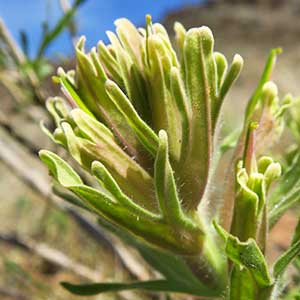Castilleja xanthotricha
Castilleja integra
John Day or yellow-hairy paintbrush, John Day paintbrush, yellow hair paintbrush, yellow-hair Indian paintbrush
entire-leaf paintbrush, foothill paintbrush, Southwestern paintbrush, squawfeather, wholeleaf Indian paintbrush, wholeleaf paintbrush
few to several, ± decumbent to erect or ascending, unbranched, sometimes with short, leafy axillary shoots, hairs erect to spreading, long, soft, eglandular, mixed with short stipitate-glandular ones.
solitary or few to several, erect to ascending, less commonly bent at base, unbranched, sometimes branched distally, hairs spreading to appressed, fairly short, soft and moderately dense, matted, unbranched, not quite obscuring surface.
green, linear, lanceolate to broadly lanceolate, oblong, or cuneate, 0.8–5 cm, not fleshy, margins plane to wavy, involute, 0–5-lobed, apex acute, sometimes rounded;
lobes spreading, linear, arising below mid length, nearly as broad as center lobe, apex acute.
green to purplish, linear to lanceolate or narrowly oblong, (1–)2–7(–9) cm, not fleshy, margins plane, sometimes ± wavy, involute, 0-lobed distally, sometimes 3-lobed, apex acute to acuminate, sometimes rounded.
3–14 × 1.5–4.5 cm;
bracts proximally greenish, rarely dull reddish purple, distally white to cream, rarely pale yellow or dull, pale pink (sharply differentiated from proximal coloration), lanceolate or oblong to narrowly ovate, (3–)5–7-lobed;
lobes ascending, linear to obovate, ± broadened distally, medium, long, proximal lobes arising below mid length, central lobe apex broadly rounded to truncate, others acute to rounded.
2–12(–15) × 1.5–4 cm;
bracts red to red-orange or orange throughout, sometimes crimson, cerise, pale salmon, or pale yellow throughout, or proximally pale green to straw colored, distally colored as above, proximal sometimes narrowly lanceolate, others elliptic to narrowly elliptic, oblong, obovate, or oblanceolate, 0–3(–5)-lobed;
lobes ascending, lanceolate, short, arising at or above mid length, central lobe apex obtuse to rounded, lateral ones acute.
curved, 17–23 mm;
tube 15–19 mm;
beak exserted, adaxially green, 5–8(–9) mm, puberulent, stipitate-glandular;
abaxial lip deep purple (color sometimes visible through calyx), green, pinkish, or pale yellow, ± prominent, slightly inflated, usually hidden in calyx, sometimes right at top of calyx, 2 mm, ca. 50% as long as beak;
teeth ascending, whitish, yellowish, pink, or green, 1–1.5 mm.
straight or slightly curved, (21–)25–45(–50) mm;
tube 17–30(–33) mm;
beak subequal to calyx or strongly exserted, adaxially green, (8–)10–17(–18) mm;
abaxial lip deep green, reduced, usually visible in front cleft, 1–2.8 mm, 20% as long as beak;
teeth incurved, green or yellow, 0.5–1.5 mm.
colored as bracts, 15–26 mm;
abaxial and adaxial clefts 3.5–7 mm, 25–50% of calyx length, deeper than laterals, lateral 2–5 mm, 12–25% of calyx length;
lobes linear, oblong, or narrowly triangular, center lobe apex usually rounded, lobes acute to rounded.
colored as bracts, (18–)21–35(–38) mm;
abaxial and adaxial clefts (6–)9–16(–18) mm, 25–33% of calyx length, deeper than laterals, lateral (2–)4–14(–16) mm, 10–15% of calyx length;
lobes lanceolate or triangular, apex acute to rounded.
= 48.
= 24, 48.
Castilleja xanthotricha
Castilleja integra
Castilleja xanthotricha is endemic to moderate elevations in the sagebrush hills of the John Day River drainage in north-central Oregon. N. H. Holmgren (1971) hypothesized that this tetraploid species is of allopolyploid hybrid origin between C. glandulifera and C. oresbia.
(Discussion copyrighted by Flora of North America; reprinted with permission.)
Castilleja integra is widespread and common in the southwestern United States. It is important to Native Americans for dyes, ceremonies, as a food preservative, and as a medicine. It is sometimes confused with C. lanata or C. miniata but has a distinctive combination of entire, narrow, strongly involute leaves, soft-tomentose pubescence of unbranched hairs, and usually entire bracts, sometimes with one pair of short lobes from the middle. The leaf margins of C. integra are usually plane, but some populations in the Chisos Mountains of Texas are wavy margined. These plants are on the higher slopes of the Chisos Mountains in montane thorn-oak vegetation, and they are also often taller and have longer, more frequently lobed leaves. These variant populations have been called C. elongata, and they deserve further study. Castilleja integra is typically a species of dry grasslands and open forests at moderate elevations. Occasional hybrids with C. linariifolia are known from Montrose County, Colorado.
The Castilleja elongata form of C. integra is in the Center for Plant Conservation’s National Collection of Endangered Plants.
(Discussion copyrighted by Flora of North America; reprinted with permission.)


